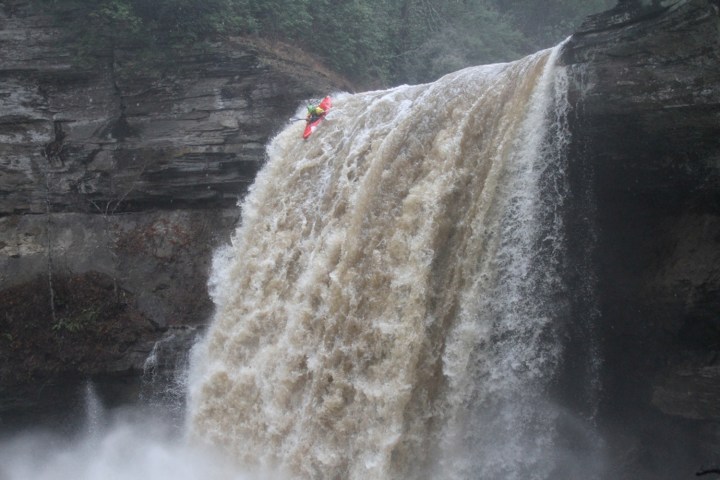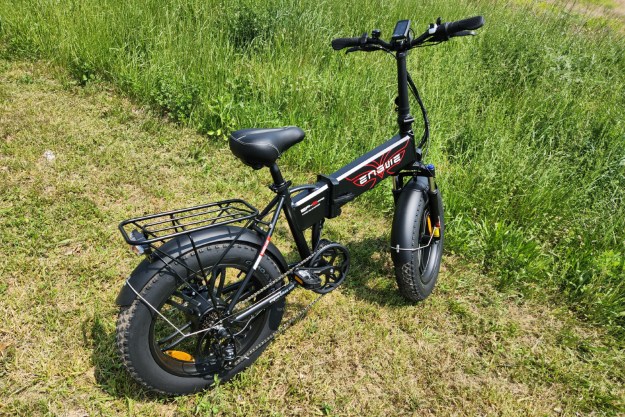
From video analysis to smart fitness trackers, technology is playing an increasing role in the lives of competitive athletes these days. But it’s not just the ones on fields and courts: Even whitewater kayakers are getting in on the game, dunking gadgets from fitness trackers to cameras in the quest for a competitive edge. Technology has changed the way they train, compete, and even travel between events.
At the GoPro Mountain Games in Vail., Colorado, we pulled aside GMC athlete Nick Troutman and his wife, professional Kokatat paddler Emily Jackson, to discuss the role that technology plays in their respective kayaking careers.
Watch it again
At the pro level Troutman and Jackson perform at, every little micro-movement can make or break a competition. But whitewater kayaking unfolds fast, and it can be hard to catch every detail in training, which makes video analysis absolutely crucial. Both athletes often stick a small camera on a rock while they’re practicing tricks to get insight into their body mechanics.
“For video analysis we use a GoPro often,” said Troutman. “We set it up on a rock and it films the entire session. You just throw it on a tripod and press record.”
Because modern cameras have such long battery lives, they can leave it running for the entire session without starting and stopping between takes, or missing any footage. That means no need to bring along a camera person, or big, heavy video equipment.
Later, they pore over the footage in slow motion. “You can really figure out, ‘What am I doing?’” said Troutman. “Either ‘What am I doing wrong’ or ‘What am I doing right? Why did this trick go bigger or better than the other trick?’ You can really slow it down and analyze exactly the difference between the moves.”
“You can analyze where exactly within the feature to do the trick.”
It’s also a great way to examine the river features that they’ll be competing on prior to the event, he said. When they arrive in town for a competition, for example, they often set up a camera near the event site to assess the water dynamics.
“You can analyze where exactly within the feature to do the trick,” he explained. “Like if I’m six inches farther this way I won’t tag a rock or I might get bigger pop or different things like that.”
In addition to the basic rewind-and-review method, there is software that allows athletes to match two clips side by side. This way, they can compare their performance to other athletes doing the same trick. This is particularly helpful when learning new tricks, he said. Although Troutman rarely uses side-by-sides at this stage in his career, they are tremendously helpful for earlier-stage athletes, he said.
Gaining the competitive edge
Given the enormous degree of stamina required for professional kayaking, it’s not surprising that fitness trackers are another common training tool. When they’re gearing up for the competitive season, Jackson said, the devices are pretty much strapped to their wrists 24-7. She wears a Garmin Forerunner 35 that not only tracks activity, but allows her to log everything eats. She syncs that data up with MyFitnessPal and she can use it to work with her personal trainer remotely — a huge asset when she’s on the road.
“You can add someone who can watch what you log,” she said. “It gives me the opportunity to have a trainer who isn’t even here.”

The two of them often schedule video calls so her trainer can look at the app stats and discuss what she’s been eating and how her training has been going.
Troutman uses Suunto’s Spartan, which has a special kayaking mode that counts your stroke rate, also known as cadence.
“It counts strokes similar to how you would counts steps,” he said.
They have an in-ear heart rate monitor that syncs with his smartphone which means he can listen to music while paddling and have his stats auto-synced.
While using it at the Mountain Games last year, he kept it on throughout the all-mountain challenge that tallies athlete’s exertion across multiple events, including things like running, biking, and paddling. On top of offering helpful performance guidance, he said it was fun to see how much energy he actually puts out during competitive events.
“On Saturday of last year I remember it looking at it and it was at like 375 percent of my daily value at 10:30 in the morning. … (This year) I had it on the whole time during the Mountain Challenge and I was at like 500 percent or something like that. I was like, ‘Sweet. Crushed it.’”
When he’s not competing, he often uses a pair of Jabra waterproof sport headphones to train, he added. They have an in-ear heart rate monitor that syncs with his smartphone which means he can listen to music while paddling and have his stats auto-synced. All of these gadgets work together to make training and competitive events more enjoyable, as well as more effective, Troutman said.
On-water technology
Training isn’t the only place where kayakers are seeing technology seeping into their sport. During competitions, the water itself is controlled by underwater electronics that help channel the water and maintain optimal levels. This is especially pervasive on rivers with water levels that fluctuate widely and has made a huge impact on the races, according to both athletes.
The mechanisms for controlling the water vary, but typically it involves an electric bladder with metal panels on top. There is a pump inside the bladder, which operates like a balloon, being filled or deflated from the river bank with a remote control. The apparatus sits just upstream from whatever hole or feature they will be competing in. As the water pours over the metal plate, the angle can be controlled, creating the foam that gives it shape.
Jackson said that before this technology was available, low water levels would sometimes destroy competitive events.
“When we competed here 10 years ago, the water flow determined everything,” she said. “We would just have a really bad hole sometimes — and it was not a great competition.”
On the road
En route to competitions, technology has trickled down into the vehicles they drive, too. Inside their truck, for example, they have a built-in hotspot they use to coordinate the details of their upcoming events and conduct all of the off-water work involved in being a professional kayaker. For athletes who spend half the year or more on the road, this can be a really big deal, Troutman explained.
“I use a lot of the technical features of our GMC Sierra while on tour and competing.”
“I use a lot of the technical features of our GMC Sierra while on tour and competing,” he said. “One of my favorites is the Apple CarPlay. It links with my phone, plays my pre-race playlists, and helps get me to the put-in and takeout, as well as the fact that it has Siri built in so I can ask the truck anything I want.”
Traveling from race to race with their kids comes with its own challenges. Troutman pointed to the built-in Blu-ray player, and other entertainment devices that make the long hauls easier. A lot of paddlers and other professional athletes have upgraded their vehicles in recent years to higher-tech rigs that allow them to work on the road.
But when you’re loading and unloading kayaks every day, there’s one piece of automotive technology you favor above all others. “Hands down, that would be the tri-mode power step,” Troutman said. “(It) folds back and makes it easy to load boats or get anything in and out of the bed on the truck. This is perfect for me, as I’m not super tall, so the step makes loading boats so much easier.”
Riding the line
When does technology become too much? Michael Tavares, a whitewater standup paddler who uses many of the same gadgets as Troutman and Kokatat, said that every athlete’s relationship with technology is different. On one hand it enables athletes to push the limits; on the other, it can detract from the natural experience of the outdoor sport if taken too far. It all comes down to the athlete and their specific personality.
“Some paddlers need technology to push them ahead and others just need to be on the water in nature,” he said. “I guess it’s more about personal preference and drive. … Technology will always continue to progress our sport, but isn’t the reason that most people are drawn to the water.”






